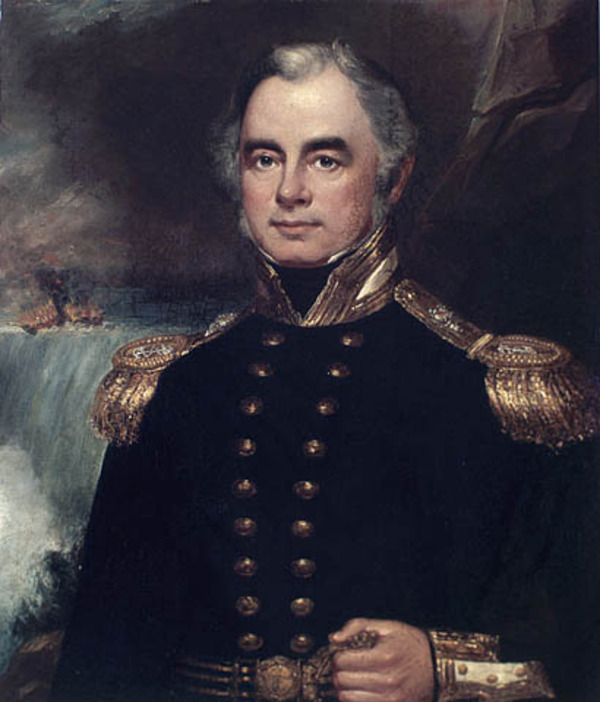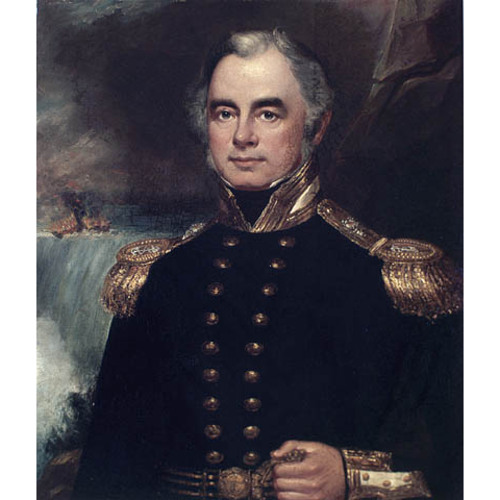DREW, ANDREW, naval officer; b. at London, Eng., 27 Nov. 1792, son of John and Mary Drew; m. in 1832 Mary Henderson by whom he had five sons and one daughter; d. in England, 19 Dec. 1878.
Andrew Drew entered the Royal Navy as a first class volunteer in May 1806. He took part in operations at Boulogne, Copenhagen, and Walcheren Island and was promoted lieutenant in 1814. He remained on active duty until 1824, when he was promoted commander for distinguished service during the Ashanti War and placed on half-pay.
In 1832 Drew entered into a partnership with Vice-Admiral Henry Vansittart to develop a farming estate in Upper Canada. Under the terms of the partnership Vansittart supplied capital of £1,800, one half on his own account and one half as an interest-free loan for Drew’s share of the capital. Drew took up land in Blandford Township in July and played a leading part in developing the district. His efforts led to the laying out of the town of Woodstock, which he had Charles Rankin survey; he erected the first church, with money supplied by Vansittart, and built some of the first houses.
When Vansittart arrived in 1834, he and Drew quarrelled. There were several reasons for Vansittart’s dissatisfaction: all the land was held in Drew’s name; Drew refused to hand the church over to the parish because, he claimed, there was money owing to him for construction costs; and certain investments made by Drew on Vansittart’s behalf did not meet the latter’s approval. As a result the partnership was dissolved, on terms arbitrated by Christopher A. Hagerman*.
Drew devoted himself to improving the land he retained – about 350 of the 700 acres originally granted, including 40 in the town plot – until the outbreak of the rebellion in Upper Canada. He was appointed to command a naval brigade attached to the force raised and led by Allan MacNab* to expel William Lyon Mackenzie* and a party of Americans from Navy Island in the Niagara River. Mackenzie’s supporters hired a steamer, Caroline, to carry supplies to the island, and on 29 Dec. 1837 MacNab ordered Drew to cut out the vessel. That night he led a naval expedition to Fort Schlosser on the American side of the river, seized the ship after a fight in which one of her crew was killed, set her on fire, and cut her adrift to burn in the river.
This affair embittered relations between England and the United States for many years. The Americans regarded the deliberate attack on an American ship in an American port and the death of an American citizen as acts of piracy and murder. In Upper Canada the attack was regarded as proper punishment for bandits who were trying to overthrow the government of the province and who should have been restrained by the American authorities. An American jury indicted Drew for murder. The American government demanded compensation for the loss of the ship, and the incident formed the excuse for the outrages of the Patriot Hunters.
Drew remained on duty during the winter of 1838, and, when Captain Williams Sandom* was sent to command the naval forces in the province, acted as naval adviser to the lieutenant governor, Sir George Arthur*. In the summer of 1838 he was ordered to prepare plans for a provincial marine which Arthur intended to use, if needed, to defend the upper lakes in the event of an American invasion of the province. In November Drew was asked to raise the force and proceed to Amherstburg to help repel a threatened attack. Damage to his two ships as a result of a fire stopped him, however, and he spent the winter at Dunnville.
He continued to serve until the summer of 1839, during which time he was employed by Arthur in various other matters, including preparations to capture Fort Niagara in the event of war with the United States. In July he was relieved of his command by Sandom on charges of being absent without leave and of signing a false muster roll. Drew requested a court martial and was acquitted but was not employed again in Canada.
In 1842 Drew left Canada, as a result, he claimed, of attempts to murder him for his part in the Caroline affair, and he never returned. In England he went back to active duty in the navy, serving in the West Indies. In 1843 he was promoted captain on half-pay and at his death was an admiral.
Andrew Drew, A narrative of the capture and destruction of the steamer ‘Caroline’ and her descent over the falls of Niagara on the night of the 29th of December, 1837 (London, 1864).
MTCL, Robert John Turner papers. PAO, Marston collection, Andrew Drew papers, 1836–1839; RG 1, A–IV, 44 (Blandford); RG 1, C–IV, Oxford East Township, Vansittart family papers. PRO, CO 42/459, 144; 42/465, 160, 166; 42/473, 41; 42/474, 134, 138. Arthur papers (Sanderson). O’Byrne, Naval biog. dict. John Ireland, “Andrew Drew and the founding of Woodstock,” Ont. Hist., LX (1968), 229–45; “Andrew Drew: the man who burned the Caroline,” Ont. Hist., LIX (1967), 137–56.
Cite This Article
M. L. Magill, “DREW, ANDREW,” in Dictionary of Canadian Biography, vol. 10, University of Toronto/Université Laval, 2003–, accessed December 19, 2025, https://www.biographi.ca/en/bio/drew_andrew_10E.html.
The citation above shows the format for footnotes and endnotes according to the Chicago manual of style (16th edition). Information to be used in other citation formats:
| Permalink: | https://www.biographi.ca/en/bio/drew_andrew_10E.html |
| Author of Article: | M. L. Magill |
| Title of Article: | DREW, ANDREW |
| Publication Name: | Dictionary of Canadian Biography, vol. 10 |
| Publisher: | University of Toronto/Université Laval |
| Year of publication: | 1972 |
| Year of revision: | 1972 |
| Access Date: | December 19, 2025 |




